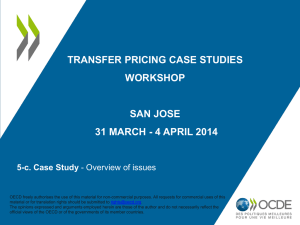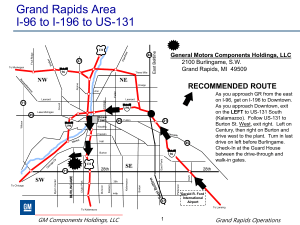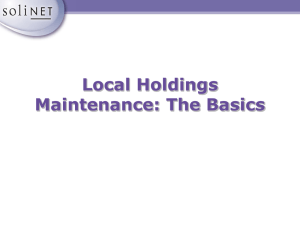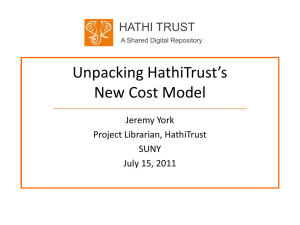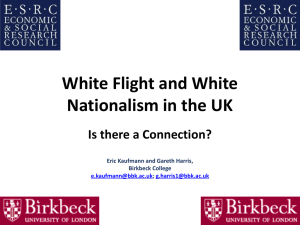2010-06-16-ny-Renick
advertisement
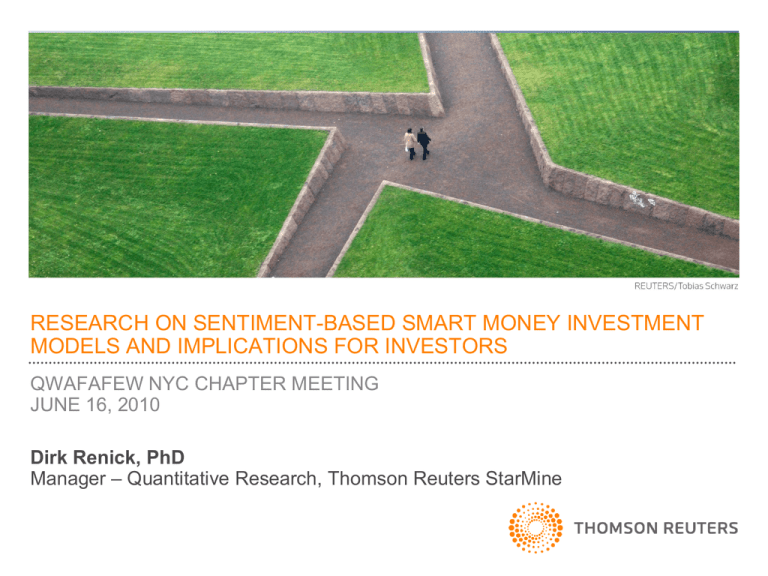
RESEARCH ON SENTIMENT-BASED SMART MONEY INVESTMENT MODELS AND IMPLICATIONS FOR INVESTORS QWAFAFEW NYC CHAPTER MEETING JUNE 16, 2010 Dirk Renick, PhD Manager – Quantitative Research, Thomson Reuters StarMine Why are we researching “smart money”? Following the dumb money doesn’t seem like such a good idea... $ Billions 12.00 5500 10.00 5000 4500 8.00 4000 6.00 3500 4.00 3000 NASDAQ Fund Flows 2.00 2500 0.00 2000 Nov-02 Sep-02 Jul-02 May-02 Mar-02 Jan-02 Nov-01 Sep-01 Jul-01 May-01 Mar-01 Jan-01 Nov-00 Sep-00 Jul-00 May-00 Mar-00 Jan-00 Nov-99 Jul-99 Sep-99 May-99 Mar-99 Jan-99 Nov-98 Jul-98 Sep-98 1000 May-98 (4.00) Mar-98 1500 Jan-98 (2.00) Tech sector fund flows 1998 - 2002 Source: Lipper FMI Monthly Technology Fund Flows, Datastream 2 AGENDA • HOLDINGS MODELS – TOP HOLDINGS – SMART HOLDINGS • INSIDER TRANSACTIONS • SHORT INTEREST • CONCLUSION, Q & A DATA MINING TIP #1: Start with a hypothesis based on economic intuition, even though mileage may vary. • Economic intuition usually implies exploiting a behavioral bias • When you get a test result, you can compare results to your baseline hypothesis, which is better than not having a well-formed hypothesis – Explore what assumptions were wrong in your hypothesis – Maybe find out that your hypothesis was only a proxy for another known market anomaly – Sometime you pick up random, interesting tidbits that can inform future hypotheses 4 Popular idea that didn’t show consistent alpha: fund manager’s “top holdings” • Hypothesis: Mutual fund managers’ top several positions comprise their most confident bets and achieve outperformance. • Fact: Their most overweight positions are largely comprised of stocks that have undergone a price run-up in the prior 1-2 quarters • Conclusion: We found inconsistent alpha performance over time, with a substantial drop between the first and second halves of our data history average monthly return α4 1997 - 12/2002 0.0131 0.0123 1/2003 - 5/2009 0.0118 0.0016 Time period 5 DATA MINING TIP #2: When the investing environment changes (gov’t action, etc.) test before and after separately. • In the case of investor sentiment models, Reg FD is an exogenous shock to the disclosure landscape – Reg FD was enacted, in part, to level the information playing field between the “smart money” and the retail investor • In the case of “best ideas” we saw a step change in factor efficacy 6 “Top Holdings” portfolios show significantly higher trailing returns than forward returns – it’s momentum Mean monthly return Rather than a function of conviction, “Top Holdings” are dominated by stocks that have run up in price in the trailing 3-6 month period. Holdings as_of_date (0 day report lag) Data available date (60 day report lag) Previous months Following months 7 Top holdings are more likely to be sold by the fund • These largest positions are more likely to be sold by the fund in the following quarter than they are to be bought further. • In the quarter following a top holding showing up, fund managers are over 3 times more likely to sell at least 5% of their position, as they are to buy more. Top holdings this quarter % being bought next Q % being sold next Q 14.6% 46.1% • This corresponds with the belief that fund managers are rebalancing to avoid being concentrated in any given position. 8 AGENDA • HOLDINGS MODELS – TOP HOLDINGS – SMART HOLDINGS • INSIDER TRANSACTIONS • SHORT INTEREST • CONCLUSION, Q & A Holdings data represents a rich dataset to model institutional and investment management behaviors Global Ownership Data • Mutual funds, HF, institutions • Global securities • 13 years of data, from 1997 (around 23 GB of data) Combine with • Fundamental data • Analyst Estimates data • Price data Understand Investor Behaviors 10 What are the fundamental factor biases of each fund/firm ? Are investors favoring value or growth this year? What stocks are most attractive to large numbers of funds ? Research into a “Smart Holdings” model of buying and selling behavior reveals some interesting biases. Research into historical holdings data uncovered several factors that help us predict future holdings: • Funds are attracted to companies that are “like” ones they already own. Likeness can be on an analyst coverage, sector or fundamental basis. • Funds exhibit biases towards buying companies with certain fundamental factors, and these biases change over time. • This is different from the definition of “conviction” or “best ideas” in the literature which attempts to use holding size as an indicator. The model is based on predicting future change in % institutional holding for each company rather than price. If we can accurately predict which stocks are likely to be bought (sold), we can forecast price increases (decreases). 11 DATA MINING TIP #3: Predicting price changes can be hard; it may be more fruitful to focus on predicting a behavioral phenomena that should drive prices. In the case of looking at holdings, we are focusing on predicting the future change in institutional holdings • Similar tactic undertaken in development of the StarMine Analyst Revisions model which predict future revisions, not price. You can validate the behavioral hypothesis with a perfect foresight model • A perfect foresight model is unachievable but useful to know that you are going after a worthwhile target. 12 By predicting what factors are most important, you can model which stocks managers will find most attractive Public filing Predict Q1 holdings one month prior Changes in % held by institutions cause price changes Predicting forward one quarter change in % Institutional ownership is highly profitable A perfect foresight model is off the charts performance. So this is worth modeling. Q1 +45 days Q0 A good measure of a stock’s popularity is % Institutional ownership. Pred. Change 12/31/07 Actual Chg Rank Ticker 9/30/07 MSFT 58.60% 61.80% 3.20% 70 IBM 65.40% 64.00% -1.40% 56 XOM 49.90% 50.90% 1.00% 53 MON 84.90% 85.40% 0.50% 41 C 65.60% 63.40% -2.20% 10 Spearman rank correlation between F1Q predicted %inst ownership and actual F1Q % inst ownership 0.14 13 Below we can see how different biases (or investing styles) come in and out of favor over time. Price momentum and growth factors dominate 1999 StarMine PriceMo LTG G5 EPS Debt/Assets Interest Coverage 2001 EPS_CAGR3 ROE Profit Margin Debt/Assets LTG 2003 ROE Profit Margin Interest Coverage LTG F12m E/P ROE, Earnings Quality and other value factors dominate 2004 ROE Interest Coverage F12m E/P Profit Margin LTG 2005 2007 ROE ROE F12m E/P F12m E/P Interest Coverage Interest Coverage Profit Margin Profit Margin StarMine EQ StarMine PriceMo in-sample years 1999-2007 The shift from growth to value matches intuition around how investors approached these different market regimes. 14 Microcap companies, which we define as not being in the top 98.5% of all market cap, can present different phenomena and potentially misleading aggregate results Average decile returns, all securities with median market cap of decile Average decile returns, top 98.5% market cap with median market cap of decile 2.5% 281M 2.0% 230M 1.5% 69M 106M 126M 1.0% 2.5% 214M 23M Avg Monthly Return Avg Monthly Return 3.0% 151M 175M 205M 0.5% 693M 2.0% 902M 1.5% 777M 612M 1.0% 360M 0.5% 431M 505M 690M 569M 234M 0.0% 0.0% 1 2 3 4 5 6 Decile 7 8 9 10 Microcaps included in Universe 1 2 3 4 5 6 Decile 7 8 9 Microcaps excluded This represents a better investible universe 10 AGENDA • HOLDINGS MODELS – TOP HOLDINGS – SMART HOLDINGS • INSIDER TRANSACTIONS • SHORT INTEREST • CONCLUSION, Q & A SOX (and perhaps the Martha Stewart trial!) represented watershed moments in efforts to model insider trading Every literature theory we tested has significant performance drop-offs after SOX. • Maybe due to SOX; maybe market cycles; maybe Martha Stewart (seriously!) “We find that the cost of equity in a country, after controlling for a number of other variables, does not change after the introduction of insider trading laws, but decreases significantly after the first prosecution.” Bhattacharya, Daouk, Journal of Finance, 2002, “The World Price of Insider Trading” 17 We investigated whether we could still get value out of insider data and found three dimensions informative • Breadth (Net Buyer Ratio) • The more agreement there is among insiders as to buying (selling), the more bullish (bearish) we should be on the company. • Buying Depth • The more $ that insiders are buying, the more bullish we should be on the company. • Selling Depth • The more $ that insiders are selling, the more bearish we should be on the company • Adjust for “why is this insider selling”: there are many reasons insiders might sell shares • Some of those reasons have little to do with their outlook for the business • We achieve better results by putting less weight on transactions that look more like compensation (e.g. an insider who exercises options and immediately sells them is probably thinking of the option grant as a bonus.) 18 DATA MINING TIP #4: Does your model improve over a simple model? Top Decile Bottom Decile Decile Spread IC StarMine Insider Model U.S. 10.3% -0.1% 6.9% 0.014 Basic Buy/Sell Ratio Model 8.7% 6.2% 2.2% 0.007 4.7% 0.007 StarMine Value Added 1996-2008; in-sample stocks only 19 DATA MINING TIP #5: Did you rediscover a well understood investor bias? Check your model against correlations of “standard” quant models (could include Beta, MCAP, etc… as well) ARM Spearman Correlation: -0.036 EQ IV PriceMo RV ValMo -0.129 0.213 -0.026 0.199 0.144 Combining the Insider model (value) with Price Momentum achieves better results than either alone, which matches well-known quant model behavior • Insiders tend to behave like value investors • When they violate this tendency, it is an especially powerful signal (e.g. when insiders sell a stock that has already declined a lot)* Quintile 1 StarMine Insider Trading Model US Quintile 1 Quintile 2 Quintile 3 Quintile 4 Quintile 5 -16.5% StarMine PriceMo Quintile Quintile Quintile 2 3 4 -9.2% -6.2% 0.2% Quintile 5 8.5% Insider trading spread = 6.5% -4.2% Price momentum spread = 18.5% Simple combination = 29.5% -7.5% -6.0% -2.0% 4.3% 7.4% -0.4% -6.4% -2.6% -1.1% 5.2% 6.2% 0.9% -9.5% -2.3% 0.8% 4.6% 11.5% 0.9% -6.3% -4.0% 0.1% 6.3% 13.0% 2.3% -9.3% -4.7% -1.5% 4.4% 9.2% Annualized excess returns of the StarMine Insider Trading Model US and the StarMine PriceMo model, alone and in combination, broken out into quintiles, for a 30-day holding period rebalanced monthly from January 1996December 2008. Quintile 1 is the most bearish; quintile 5 the most bullish. Transaction costs are not included. *consistent with Seyhun, N. 1998, “Investment Intelligence From Insider Trading”, MIT Press 21 AGENDA • OWNERSHIP ANALYTICS – TOP HOLDINGS – SMART HOLDINGS • INSIDER TRANSACTIONS • SHORT INTEREST • CONCLUSION, Q & A The fraction of U.S. stock shares sold short has increased steeply over the last 15 years Short Interest as a % of shares outstanding, top 3000 US stocks by market cap. 10.0% 9.0% 8.0% % of shares outstanding held short 7.0% 6.0% 15 year average level (3.98%) 5.0% 4.0% 3.0% 2.0% 1.0% 0.0% 1995 1996 1997 1998 1999 2000 2001 2002 2003 2004 2005 2006 2007 2008 2009 2010 This trend at least in part reflects the increased popularity of market neutral and 130/30 funds in the U.S. marketplace. 23 What are we trying to do with a short interest model? Three broad categories of short sellers represented in the raw short interest data from the exchanges: • Hedgers – risk management technique to reduce exposure incurred through long investments (130/30, pairs trades) • Arbitrage shorts – exploit mispricing between two assets or asset classes. (convert arbs, M&A arbs) • Fundamental Shorts - Valuation based shorts based on investors sentiment that the stock is overvalued by some reasonable amount or the company is going BK. This is the “smart” money making a directional bet on stock price. Our model intelligently separates the Fundamental shorts from the non-informative arb shorts, and then enhances signal due to loan availability and sell-side sentiment 24 Can you make money following the shorts? Yes, and with low turnover and correlation! Top decile – lightly shorted Cumulative return based on a long minus short strategy Bottom decile – heavily shorted • An investment strategy based on ranking top 3000 market cap US stocks by short interest as a percent of shares outstanding returned an average of 13% a year (compared to an average of 5.5% a year for the Russell 3000) from December 2003 to early 2009. • Correlations to StarMine’s existing models are low, ranging from 0.09 for EQ to 0.26 for Val-Mo. • Total average annualized turnover = 113%. Annual turnover of top decile = 38%. 25 Applying economic intuition, you can achieve superior performance by considering additional data sources beyond simple short interest level 1. Intelligently separate value shorts from the arb/hedge shorts. – Identify stocks that are likely candidates for risk arbitrage or convertible arbitrage strategies. 2. 3. Consider how ‘expensive’/difficult it is to short each stock. – Level of institutional ownership is a proxy for cost of borrowing. – Consider dividend payments as an additional cost of holding stock short. Enhancing model performance with an analyst recommendations “kicker” – When analysts have buy recommendations on highly shorted stocks go with the shorts 4. Sector affects are present in short interest sentiment 5. Beware of the dreaded Short Squeeze! – Consider risk factors for heavily shorted stocks that are likely to be squeezed. 26 Companies with convertible bond issues see a sharp rise in short interest level at the announcement date However, on average, they outperform heavily shorted companies WITHOUT convertible issues by 38bps/month. post-issue avg. (8.6%) Further 2% increase in short interest following debt issuance. pre-issue avg. (6.5%) Convertible debt issuers are more heavily shorted even prior to issue. 2003-2008 total universe avg. (4.1%) 27 Short interest can be misleading when there is convertible bond arbitrage in play – you should account for that $1.2B convertible bond issue announced 100 80 Gilead Sciences(GILD) $50.00 70 $40.00 60 50 $30.00 Price Rank of Short Interest/Shout 90 $60.00 40 $20.00 30 20 $10.00 10 0 12/1/2003 12/1/2004 12/1/2005 12/1/2006 baseline mcap neutral rank 12/1/2007 $0.00 12/1/2008 close price Low short interest rank represents a heavily shorted stock 28 Consider how expensive/difficult it is to short each stock 1. Fraction of shares owned by institutions as a proxy for borrow rate 2. Dividends – additional cost of being short 29 Conditioning on Institutional Ownership (as Rebate Rate proxy) Short Interest Quintiles • Stocks with low levels of institutional ownership are more costly to short, therefore the same short level on these names should be associated with higher expected profit. • The most heavily shorted stocks have the largest spreads when they are also in the lowest 2 quintiles of institutional ownership. lowest inst ownership most heavily shorted -0.84% 2 -1.14% 3 -0.41% 4 -0.25% highest inst ownership -3.73E-05 si only (collapse across ownership -0.53% 2 0.29% -0.21% -0.29% -0.13% 0.22% -0.02% 3 0.81% -0.01% 0.18% 0.46% 0.19% 0.32% 4 0.36% 0.20% 0.34% 0.18% 0.17% 0.25% least shorted 0.45% 0.60% 0.48% 0.46% 0.41% 0.48% 1.29% 1.73% 0.89% 0.71% 0.42% outperf. outperf underperf underperf underperf spread with ownership buckets: 1.01% 5X5 quintile plot of mean monthly returns to portfolios formed using short interest and fraction of lowest inst highest inst institutional ownership compared to baseline short interest (2003-2008) counts ownership 6247 most heavily shorted 6272 2 6275 3 2 6250 6278 6279 3 6247 6277 6279 4 6250 6276 6277 ownership 6258 6281 6282 30 Analyst recommendations “kicker” 1. Agreement – we see outperformance at the positive agree corner of our plot, and underperformance in the negative agree corner. 2. Contrarian – we also see underperformance of the High Short Interest / High Recommendations bucket (circled in red). When short-sellers and the sell-side disagree, you’re better off betting with the shorts. Short Interest Quintiles Analyst Recommendation Quintiles Highest SI = Sell short Lowest SI = Buy Quintile Spread (SI) Best = Buy -0.57% -0.11% 0.46% 0.20% 0.60% -0.41% -0.31% 0.03% 0.47% 0.58% -0.24% -0.14% -0.04% 0.16% 0.52% -0.77% -0.34% -0.12% 0.13% 0.33% 1.18% 0.99% 0.76% 1.10% Worst = Sell -0.60% -0.25% 0.01% -0.21% 0.41% 1.01% si only -0.52% -0.23% 0.07% 0.15% 0.49% 1.01% 5X5 quintile plot of mean monthly returns to portfolios formed using short interest and recommendations (2003-2008) 31 Beware of the dreaded Short Squeeze! “Short Squeeze” means different things to different people. We look for a large forward 1-month “draw-up”. What is F1M draw-up? The maximum % price increase from the first day of the period. e.g., for HOV on 2007-7-31: F1M draw-up = (16.22 - 11.95)/11.95 = 35.7% Our goal is to predict the rank of F1M draw-up, rather than an absolute value. Otherwise, we would have to arbitrarily answer questions such as: -What price increase comprises a “squeeze”? 15%? 25%? 50%? -How long does it last? Days? Weeks? Months? 32 We found that Days to Cover, a commonly used predictor of short squeezes, does not work • Days to cover = “Short Ratio” = # Shares Short / Avg Daily Volume (T1M) • Our primary measure is hit rate (0-1, higher is better). It’s the number of stocks actually in the top decile of F1M draw-up / number of stocks predicted to be in the top decile. Basically, it tells you how correct your highestconviction predictions were. • The hit rate for the short ratio is essentially the same as a random number generator. Hit Rate for Random Model = 0.1 We have developed an indicator that has a significantly better hit rate. 33 AGENDA • OWNERSHIP ANALYTICS – TOP HOLDINGS – SMART HOLDINGS • INSIDER TRANSACTIONS • SHORT INTEREST • CONCLUSION, Q & A What did we learn about smart money? It is possible to follow the smart money to abnormal returns, but... – With ownership data, you can’t just buy the “best ideas,” largest holdings, or recent purchases, you must anticipate what is going to be bought or sold in the future – With insider trading, you do much better if you isolate behavior reflecting opinion from compensation – With short interest, it’s important to separate hedging and arbitrage shorts from the fundamental bets 35 Questions? Dirk Renick dirk.renick@thomsonreuters.com 36
